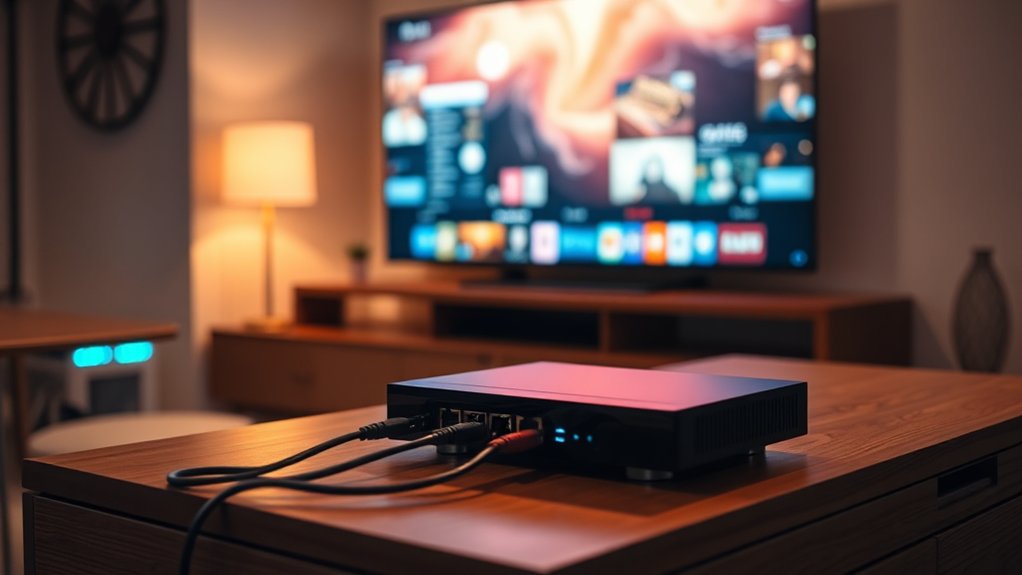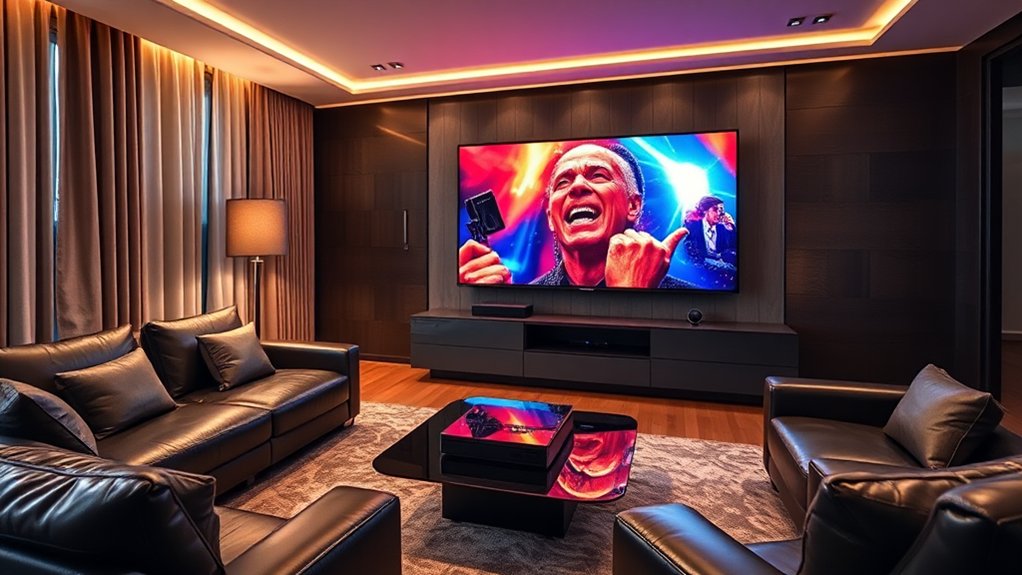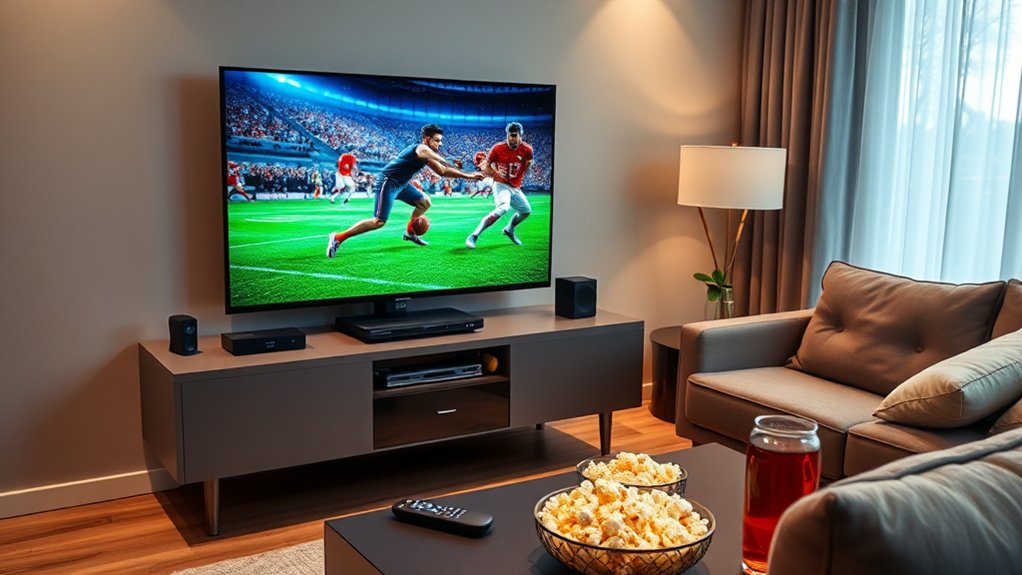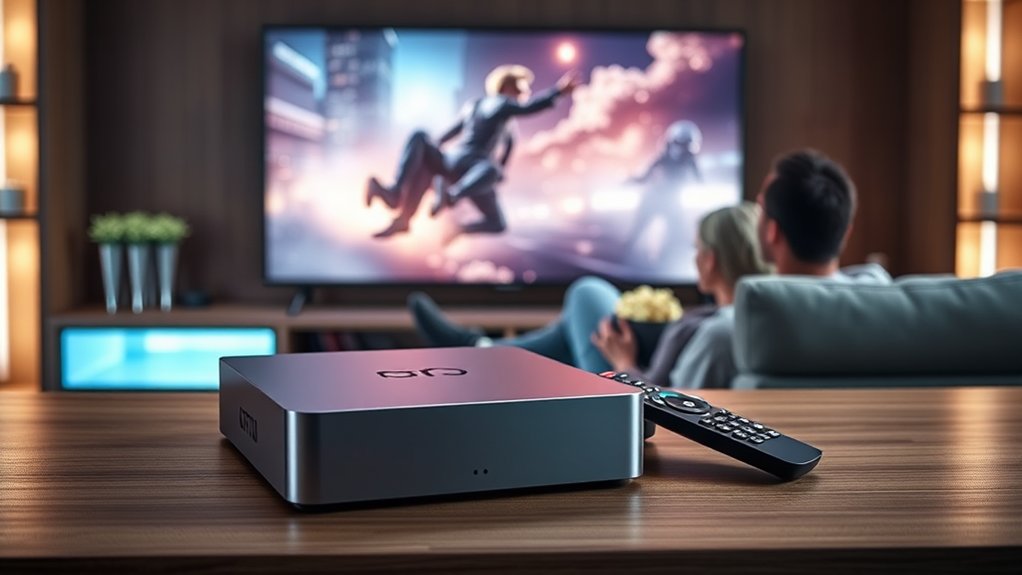To stream with your Ethernet-enabled media player, start by connecting it to your router using an Ethernet patch cable for a stable connection that minimizes buffering. Next, configure streaming software like Plex or Emby to point to your media folders. Don’t forget to set up a home media server for easy access. Optimize your network settings—consider DHCP for IP addressing. If issues crop up, check your connections, and speed might just be your streaming superhero. Want to streamline your setup even more?
Key Highlights
- Connect the media player to your network using an Ethernet cable for a stable streaming experience.
- Install and configure media streaming software like Plex or Emby for easy content access.
- Organize your media files into shared folders for streamlined cataloging and retrieval.
- Ensure your network configuration is optimized, using either DHCP or a static IP for device management.
- Troubleshoot by checking connections, speed, and settings if you experience streaming issues.
Setting Up Your Ethernet-Enabled Media Player
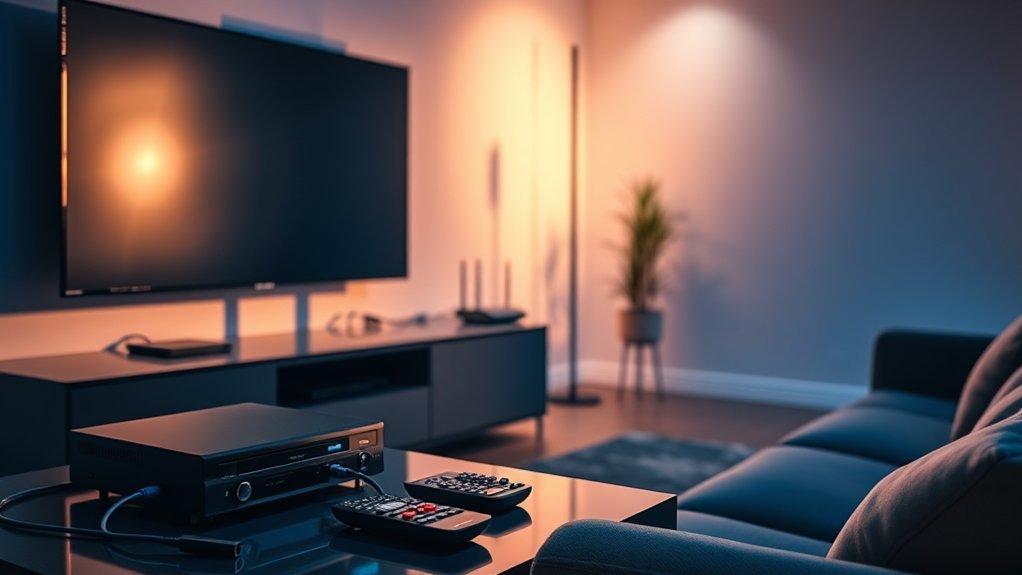
When you’re ready to set up your Ethernet-enabled media player, the first step is to make certain you have the right physical connections in place.
Start by inserting one end of your Ethernet patch cable into the media player’s Ethernet port, as the other connects to a working network port. Don’t forget to check that those connections are secure—nobody likes connectivity hiccups! Additionally, ensure that you have a blank micro SD card ready, as this is crucial for your media player’s operation.
Insert one end of the Ethernet cable into the media player’s port and the other into a working network port for seamless connectivity!
Next, plug in the power cable and power on the device by pressing the button, watching for those reassuring solid green lights.
Finally, connect the media player’s audio output to your sound system.
Is it too much cabling? Not at all! Think of it as your media player getting dressed for a big night out, ready to impress with great sound and seamless streaming!
Configuring Media Streaming Software
Now that you’ve got your Ethernet-enabled media player all set up and ready to go, the next step is to configure the media streaming software that will bring your entertainment library to life.
Start by picking a suitable streaming software, like Plex or Emby, based on what you need—think interface, device compatibility, and whether you want free or paid options.
After downloading from the official website, follow the setup wizard to install, ensuring your hardware meets minimum specs.
Don’t forget to point the software to your media folders and perform an initial scan to catalog your content.
Media servers provide centralized storage for all your media files, streamlining access and management for a seamless viewing experience.
Want it to update automatically when new files are added? You can do that too! Now, isn’t that convenient?
Creating a Home Media Server
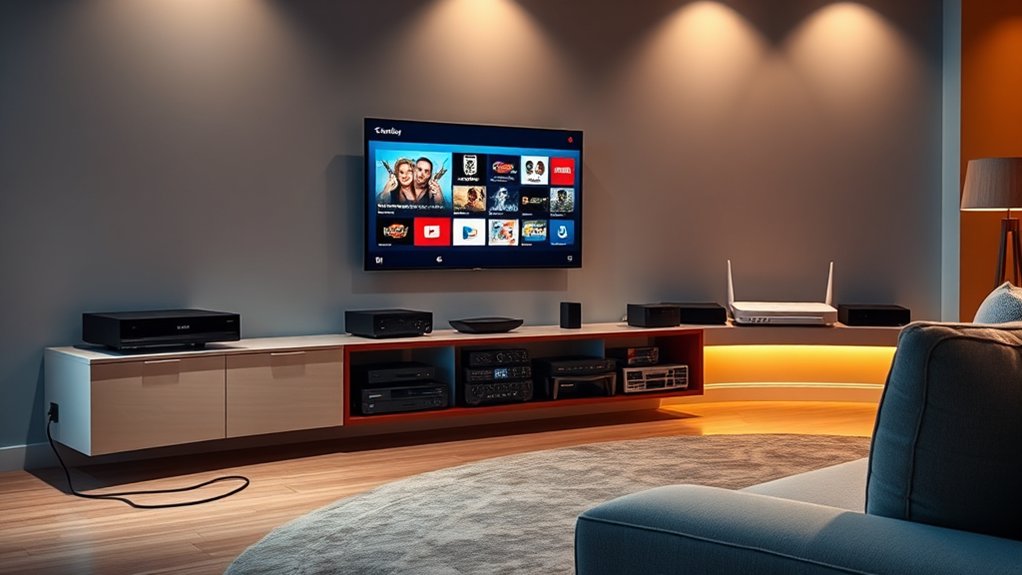
Creating a home media server can feel like an intimidating task, but it’s easier than you might think—especially with a bit of planning and the right hardware.
You could repurpose an old PC or laptop, which not only saves costs but additionally meets basic media functions. If you prefer something more dedicated, consider a Network Attached Storage (NAS) device; it’s designed for easy setup and is always on. This option allows for personal control over media access, giving you the freedom to manage your content without worrying about removals or price hikes. Additionally, choosing the right hardware configuration will ensure your server operates smoothly, providing efficient streaming to all your devices.
For those with a taste for customization, building your own server lets you control every aspect, from storage size to processing power. Remember to organize your media into shared folders—like labeling your spice jars—making access simple and hassle-free.
Believe me, once it’s set up, you’ll wonder how you lived without it!
Network Configuration and Optimization
As you begin setting up your Ethernet-enabled media player, understanding how to configure and optimize your network can make all the difference between a seamless streaming experience and the frustration of buffering screens.
First, connect the media player’s Ethernet port to your router using a LAN cable—ensure it’s snug at both ends. You can choose automatic IP addressing (DHCP) or a static IP setup, but keep in mind that reserving a static IP helps prevent conflicts.
Connect your media player to the router with a LAN cable, and consider reserving a static IP for conflict-free streaming.
Additionally, regarding security, it’s wise to use WPA/WPA2 protections and disable unnecessary network services.
Finally, for smoother operation, consider scheduling content downloads during off-peak hours—because who wants to wait for that movie to buffer?
Understanding Streaming Protocols and Compatibility
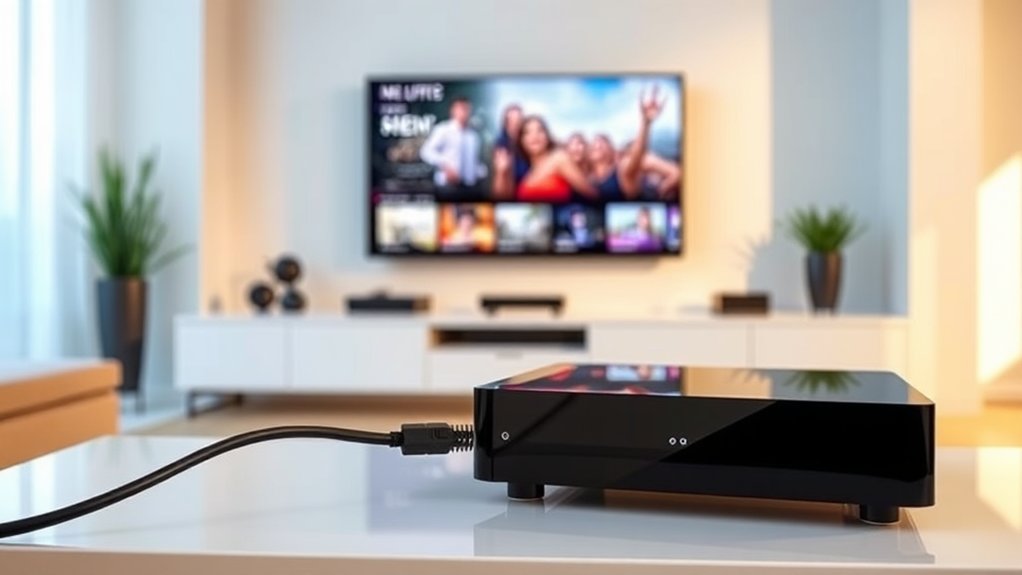
Streaming protocols are the unsung heroes of the digital entertainment world, quietly ensuring that your favorite shows and movies arrive on your screen without hiccups—well, most of the time!
Whether you’re binge-watching on Netflix or catching up on YouTube, you should know about protocols like MPEG-DASH and HLS. They adjust video quality in real-time, adapting to your network’s whims, much like a restaurant changing the menu based on what ingredients they have.
Then there’s RTMP for live streams and WebRTC for instant interactions—ever tried having a chat in a full restaurant versus a quiet café?
Finally, consider compatibility: whereas HLS loves Apple devices, MPEG-DASH is your buddy across more platforms. Choosing wisely means smoother streaming!
Troubleshooting Common Streaming Issues
When things go awry during your streaming sessions, it can feel as frustrating as trying to navigate a crowded highway during rush hour.
First, confirm your Ethernet connection is secure—damaged cables can wreak havoc. Use speed tests to verify your internet bandwidth meets streaming requirements; you wouldn’t want to run a marathon on a half-empty tank, right?
To reduce buffering, limit other high-bandwidth activities like gaming or large downloads during streaming. Sometimes, simply restarting your router or media player can clear up annoying connectivity issues.
If audio gets out of sync, checking your device settings might do the trick. Keeping firmware and apps updated too guarantees smoother performance, almost like getting a fresh set of tires for that highway drive!
Maintaining Your Media Streaming Setup
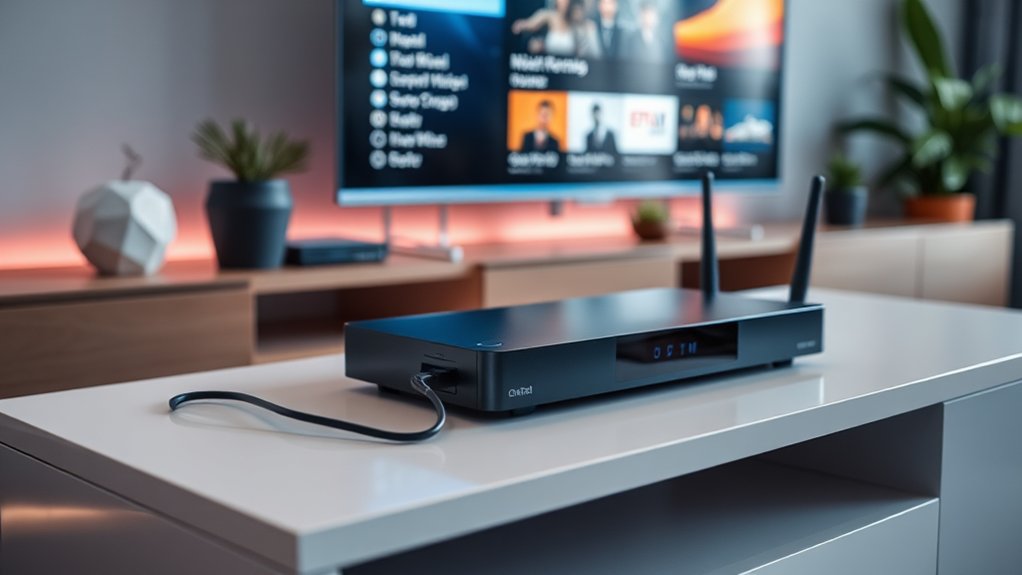
Maintaining your media streaming setup is like keeping a well-oiled machine running smoothly; a little routine care goes a long way.
Start by following a maintenance schedule that includes updating your operating systems and applications, ensuring compatibility and security.
Don’t forget to regularly audit backup data—like a safety net for your cherished media content.
Inspect your Ethernet cables and clean those ports; nobody likes poor connections, right?
Periodically review your storage space, decluttering outdated files to improve responsiveness.
And as you’re at it, conduct frequent test streams to catch any technical hiccups before they become a full-blown crisis.
Enhancing Your Streaming Experience
After confirming your media streaming setup runs like a finely-tuned engine, you might wonder how to take that experience up a notch.
One foolproof way is to utilize Ethernet connections, which provide consistent bandwidth and lower latency than Wi-Fi, effectively reducing buffering and annoying lag. By connecting your media player directly to your router via a CAT5e or CAT6 cable, you can enjoy high-resolution 4K or HDR content without quality loss.
Plus, with fewer interruptions, you won’t miss a moment of that live streaming action (and who wants to miss the final score?).
Upgrade your router if needed, prioritize your streaming traffic, and consider a dedicated VLAN.
Before you know it, your streaming experience will be like a well-orchestrated performance!
Frequently Asked Questions
Can I Use Wireless Connections Instead of Ethernet for Streaming?
Yes, you can use wireless connections for streaming. Although Wi-Fi offers mobility and convenience, its performance can fluctuate. If you need consistent quality, you might still prefer a wired Ethernet connection for critical usage.
What Is the Ideal Internet Speed for Smooth Streaming?
For smooth streaming, you need at least 3 Mbps for 720p, 5 Mbps for 1080p, and 15 Mbps for 4K. Always consider a buffer to avoid interruptions, especially during live streams or high-quality viewing.
How Can I Control Media Playback From My Mobile Device?
You can control media playback from your mobile device by using apps like VLC Mobile Remote or BubbleUPnP. These apps let you play, pause, and manage playlists directly from your smartphone smoothly.
Are There Restrictions on Media Formats for Streaming?
Yes, there’re restrictions on media formats for streaming. Your device may limit supported codecs and container types, affecting playback. It’s crucial to check compatibility for video and audio formats to guarantee seamless streaming experiences.
How Do I Reset My Media Player to Factory Settings?
To reset your media player to factory settings, press the Home button, navigate to Settings, select the Resetting option, choose your preferred settings to reset, and confirm by selecting Reset to Factory Default Settings.

